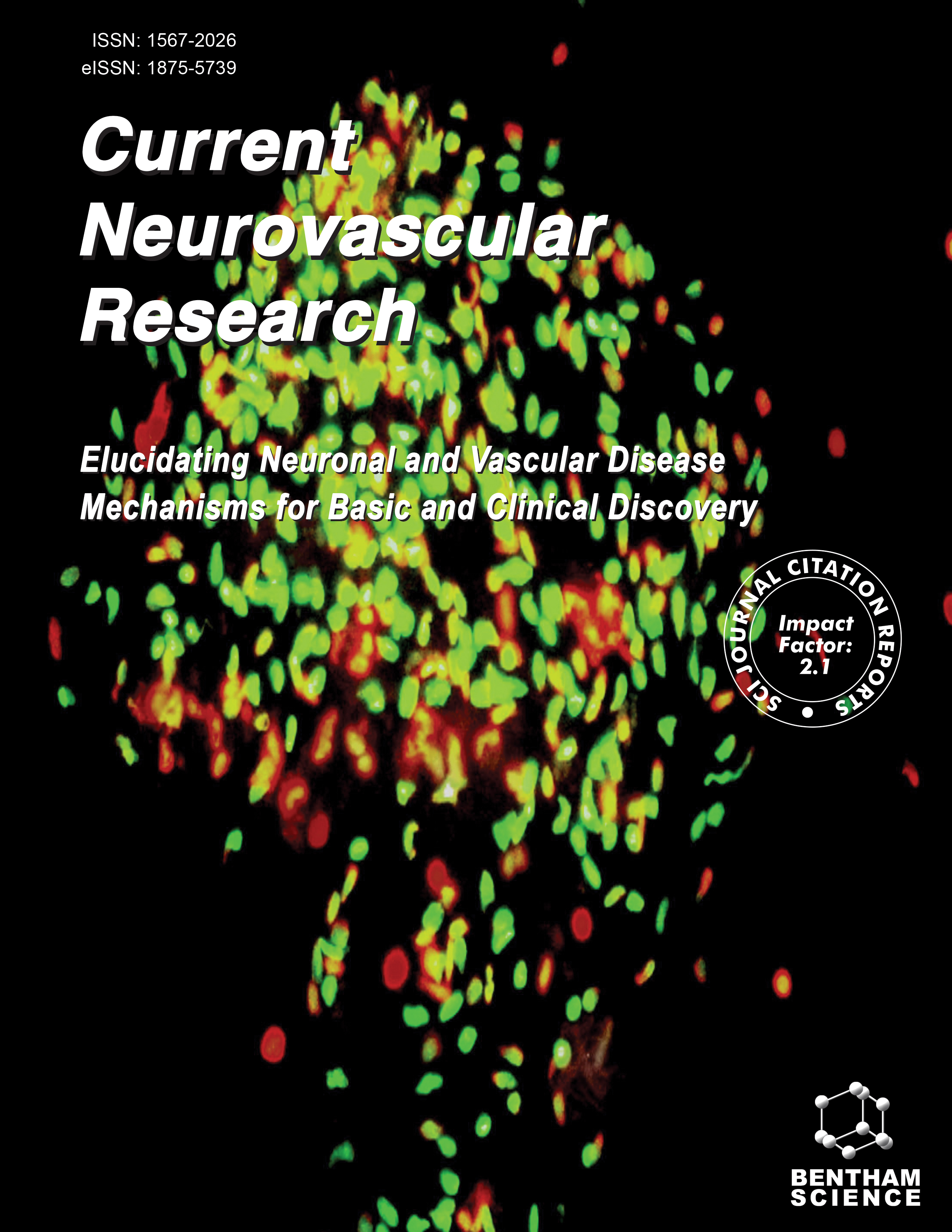- Home
- A-Z Publications
- Current Neurovascular Research
- Previous Issues
- Volume 13, Issue 4, 2016
Current Neurovascular Research - Volume 13, Issue 4, 2016
Volume 13, Issue 4, 2016
-
-
Magnetic Resonance Perfusion Imaging Provides a Significant Tool for the Identification of Cardioembolic Stroke
More LessDespite advances in imaging techniques and detailed examinations to determine the etiology of a stroke, the cause still remains undetermined in about one fourth of all ischemic strokes. The aim of this prospective study was to determine whether perfusion magnetic resonance imaging (MRI) can differentiate cardioembolic stroke from large artery atherosclerosis (LAA). We recruited 17 cardioembolic stroke and 22 LAA stroke Read More
-
-
-
Fingolimod (FTY720) Reduces Cortical Infarction and Neurological Deficits During Ischemic Stroke Through Potential Maintenance of Microvascular Patency
More LessAuthors: Michael K. Schuhmann, Milos Krstic, Christoph Kleinschnitz and Felix FluriFingolimod (FTY720) reduces infarct volume and improves neurological deficits in different rodent stroke models by modulating inflammatory and immune processes. However, studies on FTY720 regarding its non-immunological efficacy on ischemic cerebral tissue are sparse. Here we investigated whether FTY720 has cytoprotective and restorative properties following ischemic stroke in mice. Male mice received FTY72 Read More
-
-
-
Intracranial Collateral Flow Estimated by Color Velocity Imaging Quantification Ultrasound: A Protector of Recurrent Stroke in Patient with Carotid Stenosis?
More LessAuthors: Hui Fang, Xiang Yan Chen, Bo Song, Bo Cheng, Yu Ming Xu, Ka Sing Wong and Stella Sin Yee HoStroke patients with carotid disease have a high risk of recurrence of disease. By measuring cerebral blood flow volume (BFV) using extracranial duplex technique for clinical estimation of intracranial collaterals, we aimed to investigate the relationship between the presence of intracranial collaterals and stroke recurrence in stroke patients with carotid disease. Consecutive stroke patients indicated for carotid duplex ultraso Read More
-
-
-
Selective Modulator of Cannabinoid Receptor Type 2 Reduces Memory Impairment and Infarct Size During Cerebral Hypoperfusion and Vascular Dementia
More LessAuthors: Shalini Jayant and Bhupesh SharmaVascular dementia is the highly devastating neurodegenerative disorder after Alzheimer’s disease (AD) and mainly found in aged people but the effectual therapeutic target is still not there. Chronic cerebral hypoperfusion (CCH) has been broadly found in vascular dementia (VaD) patients. CCH is thought to link with neurodegenerative disorders and their subsequent cognitive deteriorate on. This study has been framed to e Read More
-
-
-
High Serum Alkaline Phosphatase Levels in Relation to Multi-Cerebral Microbleeds in Acute Ischemic Stroke Patients with Atrial Fibrillation and/or Rheumatic Heart Disease
More LessAuthors: Junfeng Liu, Deren Wang, Jie Li, Yao Xiong, Bian Liu, Chenchen Wei, Simiao Wu and Ming LiuElevated alkaline phosphatase (ALP) levels are associated with cerebral small vascular diseases, such as silent brain infarction and cerebral white matter hyperintensity (cWMH), but few prospective data are available for cerebral microbleeds (CMBs). The aim of the study was to investigate associations between serum ALP levels and CMBs in acute ischemic stroke patients with atrial fibrillation and/or rheumatic heart disease. Read More
-
-
-
TRPA1 and TRPM8 Receptors May Promote Local Vasodilation that Aggravates Oxaliplatin-Induced Peripheral Neuropathy Amenable to 17β-Estradiol Treatment
More LessAuthors: Yuwei Pan, Fengguo Chen, Si Huang, Zejian Cai, Hai Lan, Yi Tong, Xuan Yu and Guoping ZhaoOxaliplatin is a widely used chemotherapeutic agent that induces both acute and chronic peripheral neuropathy. Based on previous research indicating that estrogen replacement may attenuate some forms of pain in ovariectomized animals, we examined the effects of 17β-estradiol in OXAIPN. We discovered that local cold exposure induces an abnormal vascular response in both acute and chronic models of OXAIPN (o Read More
-
-
-
TREM2 p.H157Y Variant and the Risk of Alzheimer’s Disease: A Meta-Analysis Involving 14,510 Subjects
More LessAuthors: Teng Jiang, Jian-Kang Hou, Qing Gao, Jin-Tai Yu, Jun-Shan Zhou, Hong-Dong Zhao and Ying-Dong ZhangWe recently revealed that p.H157Y (rs2234255), a rare coding variant of triggering receptor expressed on myeloid cells 2 gene (TREM2), was associated with Alzheimer’s disease (AD) susceptibility in Han Chinese. Contrastingly, although p.H157Y was previously identified in both AD cases and controls by several sequencing studies, no association of this variant with disease susceptibility was reported. To gain a credible con Read More
-
-
-
Selective 5-HT7 Receptor Activation May Enhance Synaptic Plasticity Through N-methyl-D-aspartate (NMDA) Receptor Activity in the Visual Cortex
More LessAuthors: Kangjian Xiang, Xuefei Zhao, Youjun Li, Liang Zheng, Jue Wang and Yan-Hai LiSerotonin (5-hydroxytryptamine, 5-HT) is an important neurotransmitter that modulates N-methyl-D-aspartate (NMDA) receptor activity by binding to several different 5-HT receptor subtypes. In the present study, we used whole-cell patch-clamp recordings in transverse slice preparations to test the role of 5-HT receptors in modulating the NMDA receptor-mediated miniature excitatory postsynaptic currents (mEPSCs) in layer II/III Read More
-
-
-
Erythropoietin and mTOR: A “One-Two Punch” for Aging-Related Disorders Accompanied by Enhanced Life Expectancy
More LessLife expectancy continues to increase throughout the world, but is accompanied by a rise in the incidence of non-communicable diseases. As a result, the benefits of an increased lifespan can be limited by aging-related disorders that necessitate new directives for the development of effective and safe treatment modalities. With this objective, the mechanistic target of rapamycin (mTOR), a 289-kDa serine/threonine pr Read More
-
Volumes & issues
-
Volume 21 (2024)
-
Volume 20 (2023)
-
Volume 19 (2022)
-
Volume 18 (2021)
-
Volume 17 (2020)
-
Volume 16 (2019)
-
Volume 15 (2018)
-
Volume 14 (2017)
-
Volume 13 (2016)
-
Volume 12 (2015)
-
Volume 11 (2014)
-
Volume 10 (2013)
-
Volume 9 (2012)
-
Volume 8 (2011)
-
Volume 7 (2010)
-
Volume 6 (2009)
-
Volume 5 (2008)
-
Volume 4 (2007)
-
Volume 3 (2006)
-
Volume 2 (2005)
-
Volume 1 (2004)
Most Read This Month
Article
content/journals/cnr
Journal
10
5
false
en


